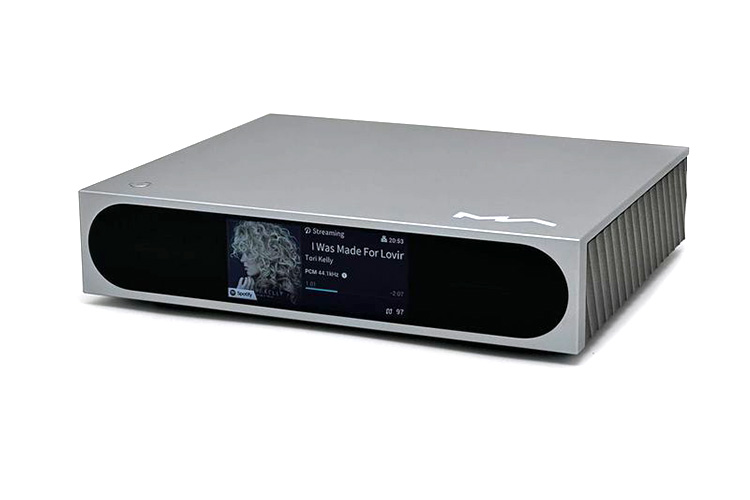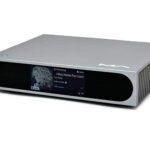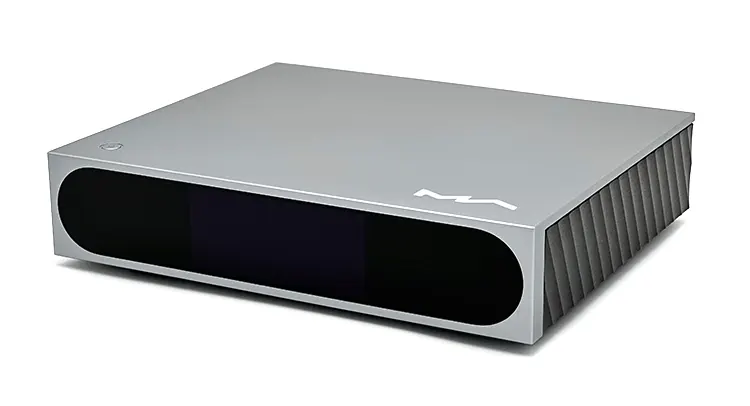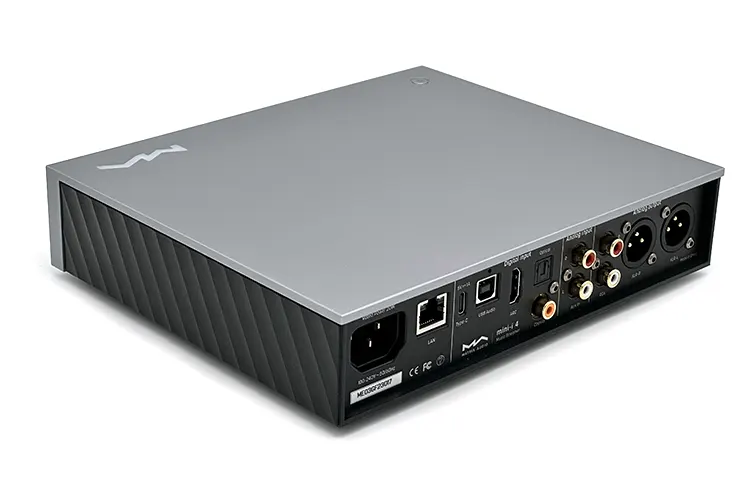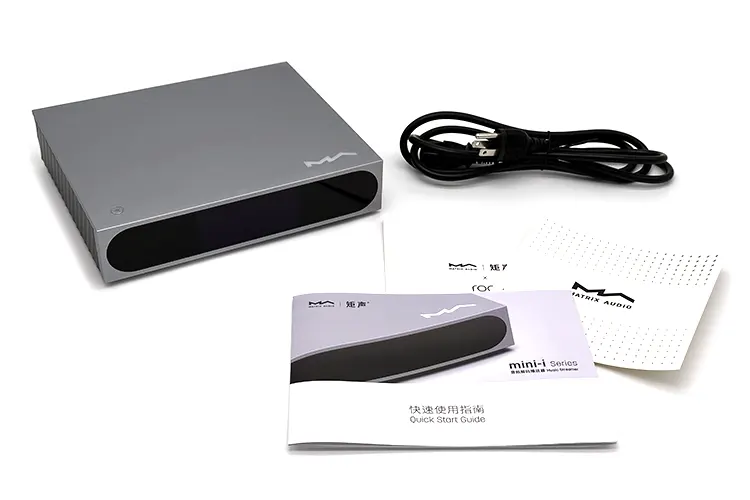Today, we review the Matrix Audio mini-i 4, which is a new ES9039Q2M-equipped DAC and Gigabit Ethernet-capable desktop audio streamer. It is priced at $649.99
Disclaimer: This sample was sent to us in exchange for our honest opinion. Headfonics is an independent website with no affiliate links or status. We thank Shenzhen Audio and Matrix Audio for this opportunity.
To learn more about streaming products previously highlighted on Headfonics you can click here.
Note, that this feature follows our current scoring guidelines which you can read here.
In 2006, the three friends and founders of Matrix Audio decided to pursue their passion for building audio gears which they probably realized when they built their first speaker in 2001. Fast forward to today, the Xi’an-based company has fostered a reputation of excellence by maintaining a core belief in its independent R&D.
In putting the utmost attention to every detail, owners of Matrix Audio products enjoy the benefit of a long product life cycle. For good reason though since the X-SABRE and element line of streamers joining the mini-i series only grows more premium.
We’re not strangers to the Matrix Audio brand here at Headfonics. Crazily good in keeping their brand image and product quality consistently high, Matrix Audio is not yet a household name but I always look out for their products.
Having owned the mini-i Pro 3 twice, I was ecstatic when the mini-i 4 launched baked with features that finally tackled the previous model’s reservations regarding streaming. Let’s also see if it has what it takes when put up against the likes of the iFi Audio NEO Stream and the EarMen Staccato.
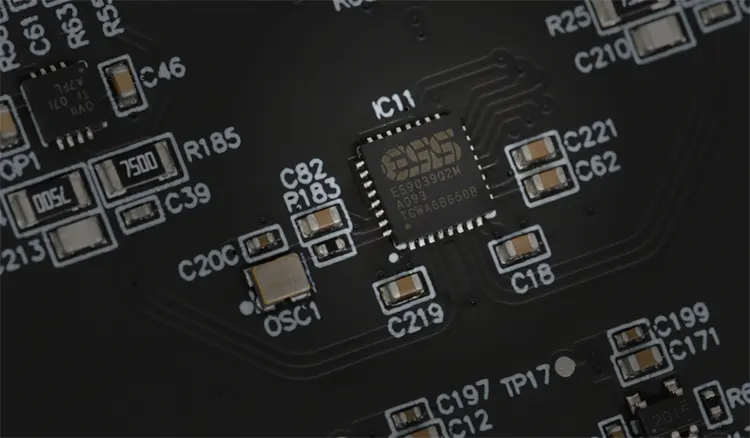
Tech Highlights
The mini-i 3 series received generally positive reviews when it launched. While I can’t deny its sonic performance, it still seemed unripe to me at the time for streaming purposes. Just ROON and Airplay capable, the choices were short and limiting for the average user.
Featuring additional ways to listen, a whole lot more actually, the mini-i 4 overcomes the hurdles of the previous generation. Aside from being able to talk seamlessly with streaming platforms like Spotify and TIDAL out of the box, a new USB storage reader now allows locally stored files to be played through the MA Remote app.
All digital data is routed through a lone ES9039Q2M DAC chip, a recently released converter from ESS. It updates the very popular ES9038Q2M on the mini-i Pro 3 to HyperStream IV, improving the dynamics and distortion numbers.
Without the ‘Pro’ to its name, the mini-i 4 omits the 2.2W headphone amplifier and WiFi receiver of its more expensive brother. It is a bit surprising though that even the mini-i Pro 4 no longer includes a Bluetooth input even though it came as standard with the 3rd generation.
Design
More of an evolution, the chassis of the mini-i 4 has been squared off and the dense shield now wraps to the top. In showing fitting respect to its history, what’s kept is the iconic shape of the glass panel that’s stretched with a slim border.
Aside from the power button, the controls are now reserved to touch sensitive areas. I still prefer physical knobs and wheels, especially for quick volume adjustments but I understand the aesthetic appeal of not having one.
The 3.46-inch LCD in the middle is bright and vivid. It is easy to appreciate the album art of the currently playing track even from a distance. I don’t think it is possible to change the background though unlike with the mini-i Pro 3.
The mini-i 4 is a modern yet simplistic device that knows how to bring out its strengths. It may not be intentional on Matrix Audio’s part, but versus their previous design, I think that the latest iteration now ties better with the higher-end element series.
I/O
With the convenience of streaming over WiFi with my previous mini-i Pro 3, I now miss the flexibility of a completely cordless setup with the new mini-i 4.
Those like me who wish for this feature will have to look elsewhere or consider the mini-i Pro 4 which has a dual-band WiFi receiver in addition to the Gigabit Ethernet port available on either model.
Designed as a music streamer, Matrix Audio still did not skimp on other types of inputs. I think the headline here is the entrance of Type-C USB storage and NAS reader which wasn’t even available in the mini-i Pro 3. It is a low-key upgrade over the previous generation that extends its capabilities to a wider group of users.
Noticing that there is no digital output to bypass the DAC, it seems that the only way to get sound out of the mini-i 4 is for the digital signal to first pass through the SABRE chips. But not limited to LAN and digital connections, it is also possible to abridge the role of the mini-i 4 into a modest pre-amp by using the RCA analog input.
With a nimbler circuit design lacking a headphone amplifier in front, the mini-i 4 only sports an XLR and RCA ports in the rear to pass music downstream. Balanced users will be plugging into the high-quality Neutrik mounts Matrix Audio fitted to the mini-i 4.
Control
Setup
Handily compatible with common household voltage levels, the mini-i 4 removes the switch the mini-i Pro 3 had for choosing between 115V and 230V sockets.
The unit seems to have a bug though that loops the bootup cycle stopping the sequence in the middle and then shutting down over and over even though I’m yet to turn it on. At least it doesn’t happen anymore when the mini-i 4 is in use or standby mode.
I initially fired up the unit using USB audio only. The Ethernet indicator was red and the clock simply counted up the minutes from zero.
But connecting the mini-i 4 to the internet is pretty painless. From the off state, both the clock and Ethernet info are already updated correctly the moment the loading screen finishes booting up.
With the mini-i 4 accepting signal over the internet, streaming platforms can already see it as an output device without needing to install the MA Remote app. Still, it only took a few minutes for me to download the app and the automatic pairing process found the mini-i 4 seamlessly.
Settings Menu
Those who have owned the Mini-i Pro 3, especially before it got updated to work with the MA Remote app, would know the struggle of having to do some ‘guesstimating’ where in the rear panel is the settings button.
I think Matrix Audio caught on that it shouldn’t be a thing. Removing this awkwardly placed button on the mini-i 4 however means that aside from the bare minimum, all the other functions and neat tricks it can do is set aside for those who installed the app.
So, on the unit itself, the arrangement of controls is simple. There are only two pairs of touch panels on either side for setting the input and volume, then there’s the swipe left and right operation on the display for some additional options like remote control pairing, updates, and more.
The display remains lit up as long as the unit is not on standby so there’s no question where to swipe when needed. On the other hand, in helping to keep a clean look, the arrows dim after a few seconds of inactivity which makes it hard to judge at times the location of the touch-sensitive area.
Having a minimalistic design also makes the initial getting to know awkward since there are no labels to tell at a glance which of the arrows is for volume and which is for the inputs.


Mobile App
UI/UX
This is the first time I’ve used the MA Remote app and I was encouraged to see how well executed it was. With a purposeful layering of controls and a friendly UI free from clutter, it achieves its committed objective to be a practical extension for the mini-i 4.
Click on the topmost area where the app shows the unit’s model and custom name to either open a different streamer or configure device-specific settings. Most of the settings I was looking for from the touch panel display of the mini-i 4 like the standby duration and screen brightness are here.
On the other side of the mobile app is the search button and remote function. The layout of the remote is not as matched to the design of the mini-i 4 unlike the RM5 and it also includes PCM filters instead of playback controls.
The rest of the screen is occupied by the currently selected section of the app which distinctly separates each type of content from the other. Whether you want to use your local files or stream from popular platforms, the MA Remote app makes it easy to distinguish where you are at any moment.
Playback
Merely complementing the general image drawn by the MA Remote app, the main player is admittedly a bit one-dimensional. It may have an undecorated expression, but its excellent composure in handling tasks at hand is what makes it appealing to use.
Just like with any player out there built into a multifaceted app, the area it covers can either take up the entire screen or be minimized to a small portion of the bottom half to gain some breathing room for other assignments.
In any case, the player will almost always be visible unless the app is on the remote-control page or searching. When streaming from online platforms, the player shows the album art with a badge on one corner indicating which streaming service it is currently pulling the data from.
Aside from the main area where playback controls are, there is also a dedicated section for showing what is in the queue.
Streaming
There’s no mention of the mini-i 4 being ROON certified yet anywhere online but just like before that should be coming soon. Those who want to listen to their local library though now have the choice to simply plug in a drive behind the unit and use the player on the MA Remote app.
Subscribers of streaming platforms like Spotify and TIDAL will enjoy the smooth handshake between its dedicated controls and the MA Remote player.
Aside from gracefully syncing the information, the forwarded task to the main unit is free from hiccups. If anything, it is only the album art shown on the mini-i 4 display that sometimes plays catch-up even though the song is already playing.
I also played a bit with Airplay 2 since it is an older feature of the mini-i Pro 3. Using the MA Remote player to control my MacBook that’s connected to the mini-i 4 via airplay, everything was smooth sailing until I tried pausing a song using my laptop instead of the app, and the connection dropped.
Packaging & Accessories
The mini-i 4 has a short packing list. Meaning, that there should’ve been very little to expect when unboxing. The way it is packaged however is interesting not only because it is triple-boxed but also because it contains 2 additional power cables instead of one.
Aside from a few paper works including a quick start guide, only the unit itself wrapped in plastic and protected by two blocks of foam is left to meet.
Click on page 2 below for sound impressions and our selected comparisons.

